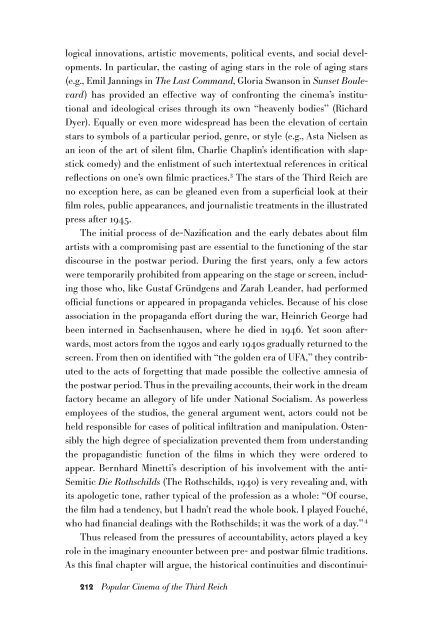You also want an ePaper? Increase the reach of your titles
YUMPU automatically turns print PDFs into web optimized ePapers that Google loves.
logical innovations, artistic movements, political events, and social developments.<br />
In particular, the casting of aging stars in the role of aging stars<br />
(e.g., Emil Jannings in The Last Command, Gloria Swanson in Sunset Boulevard)<br />
has provided an effective way of confronting the cinema’s institutional<br />
and ideological crises through its own “heavenly bodies” (Richard<br />
Dyer). Equally or even more widespread has been the elevation of certain<br />
stars to symbols of a particular period, genre, or style (e.g., Asta Nielsen as<br />
an icon of the art of silent film, Charlie Chaplin’s identification with slapstick<br />
comedy) and the enlistment of such intertextual references in critical<br />
reflections on one’s own filmic practices. 3 The stars of the Third Reich are<br />
no exception here, as can be gleaned even from a superficial look at their<br />
film roles, public appearances, and journalistic treatments in the illustrated<br />
press after 1945.<br />
The initial process of de-Nazification and the early debates about film<br />
artists with a compromising past are essential to the functioning of the star<br />
discourse in the postwar period. During the first years, only a few actors<br />
were temporarily prohibited from appearing on the stage or screen, including<br />
those who, like Gustaf Gründgens and Zarah Leander, had performed<br />
official functions or appeared in propaganda vehicles. Because of his close<br />
association in the propaganda effort during the war, Heinrich George had<br />
been interned in Sachsenhausen, where he died in 1946. Yet soon afterwards,<br />
most actors from the 1930s and early 1940s gradually returned to the<br />
screen. From then on identified with “the golden era of UFA,” they contributed<br />
to the acts of forgetting that made possible the collective amnesia of<br />
the postwar period. Thus in the prevailing accounts, their work in the dream<br />
factory became an allegory of life under National Socialism. As powerless<br />
employees of the studios, the general argument went, actors could not be<br />
held responsible for cases of political infiltration and manipulation. Ostensibly<br />
the high degree of specialization prevented them from understanding<br />
the propagandistic function of the films in which they were ordered to<br />
appear. Bernhard Minetti’s description of his involvement with the anti-<br />
Semitic Die Rothschilds (The Rothschilds, 1940) is very revealing and, with<br />
its apologetic tone, rather typical of the profession as a whole: “Of course,<br />
the film had a tendency, but I hadn’t read the whole book. I played Fouché,<br />
who had financial dealings with the Rothschilds; it was the work of a day.” 4<br />
Thus released from the pressures of accountability, actors played a key<br />
role in the imaginary encounter between pre- and postwar filmic traditions.<br />
As this final chapter will argue, the historical continuities and discontinui-<br />
212 Popular Cinema of the Third Reich

















